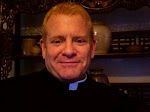Hidden
from our Eyes
27
May 2015
Homily
preached at 2 p.m. Sung Rite I Funeral with Eucharist
For
Fredric Martin Latty
Parish
Church of Trinity Ashland (Oregon)
Matthew
5:3-12
God,
give us hearts to feel and love. Take away our hearts of stone,
Fred and his family asked for most of
the details of today’s service: sung Rite I, Holy Eucharist Prayer 1, incense,
and bells. He also asked for the
beatitudes as the Gospel.
Jesus’ beatitudes suffer from our
familiarity with them. We think the beatitudes are moral targets, the way Jesus
wants us to be: be-attitudes. Not so! Beatus
in Latin means “blessed.” A beatitude is just a phrase that starts
with the word “blessed.”
Jesus’ society, like ours, praised
certain things, and called certain people happy or blessed. But Jesus turns these on their head.
“It’s a good thing to be hungry, it’s
a good thing to be poor, it’s a good thing to mourn, to be
excluded.” Really?
Obviously,
whatever it was that the historical Jesus said, it troubled his
followers. Both Matthew and Luke interpret these sayings in very
different ways, a sign that Christians then struggled with these sayings just
as we do.
Jesus turns conventional views on their
head. Some things, let’s admit it, are just bad: starvation,
hardship, sorrow at a loved one’s death, social exclusion. Some
things are just good: having enough food and money to provide for yourself and
family, being well. But Jesus is not so sure.
It’s easy to think that God blesses
good people with good things and punishes bad people with bad things. But Jesus knows that bad things can happen to
the good and that the evil can prosper. He says, “You misunderstand what
a blessing or a curse is. Things are not as they appear.”
Announcing the coming of God’s reign,
Jesus sees God at work exactly where we expect not to find him: hunger,
yearning, dependence, and vulnerability are all signs of God’s active presence
and saving work, not marks of God’s curse or punishment.
It is important, profound
theology. He is not making light of suffering, or saying, “it’s not all
that bad.” He knows that hunger, sickness,
grinding poverty, misery, deprivation, grief, and deadly exclusion inflicted on
marginalized people are all truly intolerable and not what God
wants. He is not trivializing suffering, but magnifying grace. God is the answer to, not the source, of
horror.
Isaiah 45:15 says “Truly you are a God
who hides himself, the God and Savior of Israel.” St. Thomas Aquinas draws from this to develop
his doctrine of Deus Absconditus, the Hidden God. God by definition is hidden, but if you have
faith in God, it is God whom you must wholly trust.
Horror, Evil, Death in the world—these
are not evidence that God does not exist. Rather, the fact that we
revolt against them and find them intolerable is one of the strongest evidences
of God. Our idea of justice and right
cannot grow merely from this messed up world we live in. Rather, it comes
from God himself, imprinted in the creation of God bearing God’s image, written
in our hearts. Immanuel Kant expresses this when he says that he finds
evidence for God not just in how the stars are moved above, but also in how our
hearts and minds are moved.
Buddhism teaches that all suffering
comes from attachment; getting rid of all desire will end suffering. Christianity teaches that while we must
learn acceptance and patience, it is all right to feel the discomfort and pain
caused by need and dissatisfaction with wrong. In fact, it is essential
because God is at work in such need and discomfort.
Each of the beatitudes includes
dissatisfaction: hunger, grief, need. Mourning is unhappiness at the loss
of a loved one, not a state of acceptance. Neediness and hunger do not
describe satisfaction, but desire for something different that what we now
have.
Reinhold Niebuhr's great "Serenity
Prayer" is misnamed. It is not a
prayer only for serenity to accept the things we cannot change. It
also prays for courage to change the things we can. It also
asks for wisdom to know to distinguish between the two.
God at work in the day-to-day things of life, even its horrors, is a key idea in Jesus’ preaching, his announcement that “God’s Reign is in your midst”.
So how does this apply to us
today?
We love Fred, but no longer see him. This does not mean he no longer exists. Fred lost his kidney function three years ago
through a medical accident, and this is eventually what killed him, after years
of suffering through dialysis. But this
does not mean that he was abandoned, or punished, or left to random
chance. It does not mean that we are
abandoned to random chance. It does not
mean that God is not here present in these shocking reminders of our own
mortality.
God is there, where we least expect to
find him, says Jesus. Blessed are the
poor. Blessed are the sick. Blessed are the dead.
Fred was an honest man, one who
recognized his own doubts, fears, and failings.
But his faith was that God was made human in the little baby Jesus, and
somehow God acted to save us by submitting to unjust torture and death by the
Roman Empire. Fred knew that faith was
having hope and trust exactly in the places where we doubt the most.
This very traditional funeral is a Mass
of the Resurrection, a celebration of hope in the face of death, of confidence
in the face of sickness, and of grateful joy in the face of all it means to be
human, good and bad.
Thank God for such hope, confidence,
and joy. And thank God for our brother
Fred.
In the name of Christ, Amen.




















